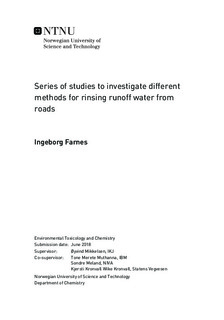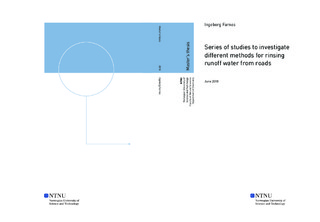| dc.description.abstract | Runoff from roads contains a wide range of pollutants such as inorganic compounds and organic compounds which can be dissolved or particle-bound. The dissolved contaminates are often more mobile and therefore also bioavailable which makes them compounds of concern for the environment. When the pollutants are dissolved it becomes more difficult to remove them with the methods used today. A series of studies was incorporate in this thesis study of different treatment options for road runoff, having field work on three completely different locations relevant for the assignment. The first location of field studies was in Bergen at the Raingarden the municipality have constructed as a solution for urban and some road runoff including keeping the groundwater at a stabile level. Even though raingardens are not an approved treatment option for road runoff, the idea was to look at passive samplers compared to manual samples and if the raingarden adsorbed any heavy metal pollution from the road. The second location of interest was a test site build simultaneously as the E18 highway between Enköping and Västerås as a location to easily measure the impact the road has on the environment. The idea was to study two different ways of road runoff treatment, as they had built an infiltration area for the runoff from the road shoulder and another well which came directly from the middle of the road. Passive samplers were used to measure the accumulated concentrations over the time period they were deployed. The third location was at the hydraulics laboratory in Trondheim were a big scale swale was already constructed with three different filter materials to investigate the ability of the materials to retain heavy metals with an increasing concentration of road salt. Passive samplers were used as well as manual sampling. The filter materials tested was pine bark Pinus Sylbestris, granulated olivine Blueguard® G1-3 and bioretention or raingarden. A metal mix with zinc, copper and nickel were added to the water solution along with three different salt concentrations (0,100mg/L and 3000mg/L NaCl).
The raingarden in Bergen showed very high concentrations from the DGT samplers compared to the manual samples, which were similar to those found in previous studies from raingardens and runoff in general.
The test site in Sweden resulted in concluding that there was a significant difference between the untreated well water and the water from the infiltration area, implying that with a few measures the water quality from the road runoff could improve considerably.
Results from the experiment done in the hydraulics laboratory show that there is a significant difference between the sampling methods, but the impact on salt on the different material varies between the metals. There is no doubt there should be more extensive studies on this subject, and more interesting would be realistic field studies. | |

